In the animal kingdom, reptiles have always been especially interesting. Clever behaviors, fascinating adaptations, and vibrant colors all make this class of animals incredibly unique. Reptiles come in a broad range of shapes and sizes, scaling from one inch long to 10 feet long! Reptiles exist on every continent besides Antarctica, including North America. A diverse group of reptiles inhabit North America and each have their own unique and intriguing characteristics. This article will explore the seven most interesting reptiles in North America!
#7: American Legless Lizard
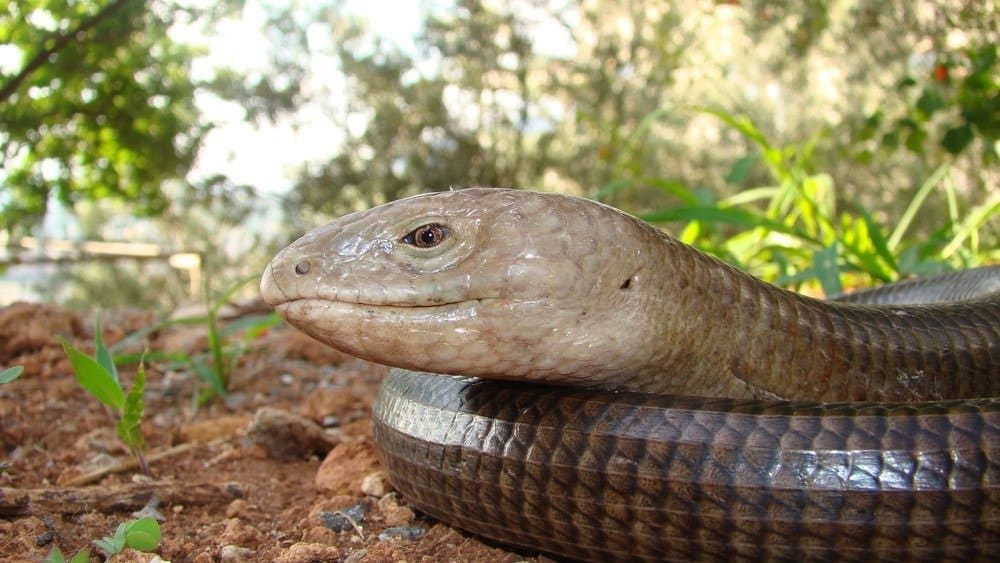
Legless lizards are often mistaken for snakes.
©Dr.MYM/Shutterstock.com
One of the most interesting reptiles in North America is the American legless lizard. The American legless lizard lives primarily in southern California and Mexico. Sandy areas along the coast are their preferred habitat. These lizards primarily feed on insect larvae, beetles, and other small invertebrates. American legless lizards are stealthy creatures and are not accurately counted in the wild, but their conservation status is still least concern.
At first glance, legless lizards look like snakes, however there are some key differences. First, legless lizards have a short body and a long tail, whereas snakes have a long body and a short tail. Legless lizards also possess eyelids and external ear openings unlike snakes. They also lack the broad belly scales and the forked tongue of a snake.
#6: Nile Monitor

Nile monitors are known for their distictive yellow coloration.
©Dave Montreuil/Shutterstock.com
A fascinating reptile in North America is the Nile monitor! The Nile monitor is a large lizard in the same genus as Komodo dragons, the largest lizards in the world! Nile monitors are typically 3 to 7 feet long and can weigh up to 44 pounds. The Nile monitor is the largest species of lizard in North America! This reptile has a conservation status of least concern.
Nile monitors are an invasive species, meaning they were introduced to a new environment and have had severe negative effects on the ecosystem the entered. They originate in Africa and now inhabit Florida where they have had a tremendous impact on local species since 1990. Nile monitors have devastated crocodile and alligator populations by preying on smaller species, destroying nests, and stealing eggs. They also prey on other reptiles, birds and bird eggs, and small mammals. There are many claims of domestic and feral cat disappearances in Cape Coral supposedly linked to the increase in lizards.
#5: Alligator Snapping Turtle
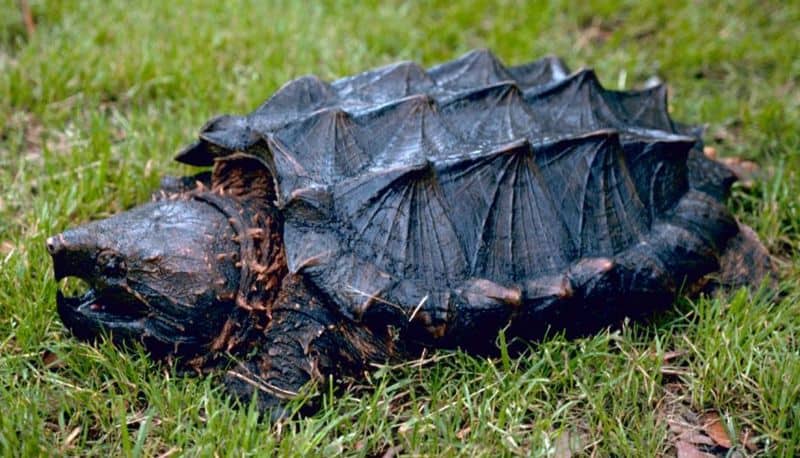
A small alligator snapping turtle.
©Gary M. Stolz / Public Domain
The alligator snapping turtle is another interesting reptile living in North America. Alligator snapping turtles are native to fresh bodies of water in the southeastern United States. They are the largest freshwater turtle in North America! There is an unverified account of a 403 pound alligator snapping turtle in Kansas in 1937. Although, their typical weight is between 19 and 176 pounds. The alligator snapping turtle is currently listed as a vulnerable species.
This massive snapping turtle has a broad diet. It scavenges for carrion (decaying animal flesh) and hunts primarily other turtles, fish, amphibians, and mollusks. Alligator snapping turtles are opportunistic feeders, meaning they will scavenge and hunt a large variety of organisms based on what is readily available. In addition to their typical prey of smaller turtles and fish, alligator snapping turtles also occasionally hunt aquatic rodents, small mammals, small reptiles including small alligators, and invertebrates.
Alligator snapping turtles have a unique hunting strategy. These turtles are primarily nocturnal hunters. At night, they position themselves at the bottom of murky water. They sit still with their mouth open, revealing their worm-like tongue. The snapping turtle moves its tongue to mimic a worm and lures its prey into its mouth. When the prey is within range, the turtle’s mouth snaps shut with great speed and force.
#4: Burmese Python
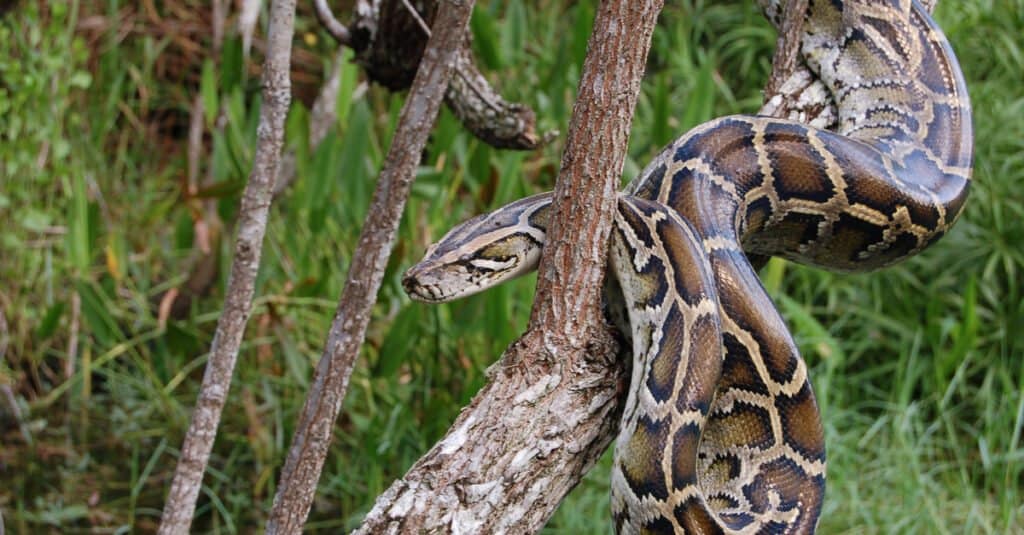
A
Burmese
python in a tree.
©Heiko Kiera/Shutterstock.com
Another interesting reptile in North America is the Burmese python. This massive snake is one of the largest in the world! They are typically 16 feet long and weigh 40 to 200 pounds. The longest Burmese python ever recorded was a female raised in captivity that reached 18 feet 10 inches long! The heaviest ever recorded weighed a massive 403 pounds!
As the name suggests, the Burmese python is not native to North America. This snake is originally from southeast Asia until its introduction to the American wild in 1992. A hurricane destroyed a python-breeding facility which led to the occupation and proliferation of Burmese pythons in Florida. Like the Nile monitor, Burmese pythons are an invasive species.
As Burmese python numbers continue increasing in Florida, several other local species suffer the consequences. These pythons feed on foxes, rabbits, opossums, and white-tailed deer. Not only does this predation negatively impact the prey populations, but Burmese pythons are also competing with other predators. American alligators rely on many of the food sources the Burmese python is depleting and now must compete for access. The introduction of a foreign species to a new environment risks the new species growing uncontrollably and putting the ecosystem out of balance.
#3: American Crocodile
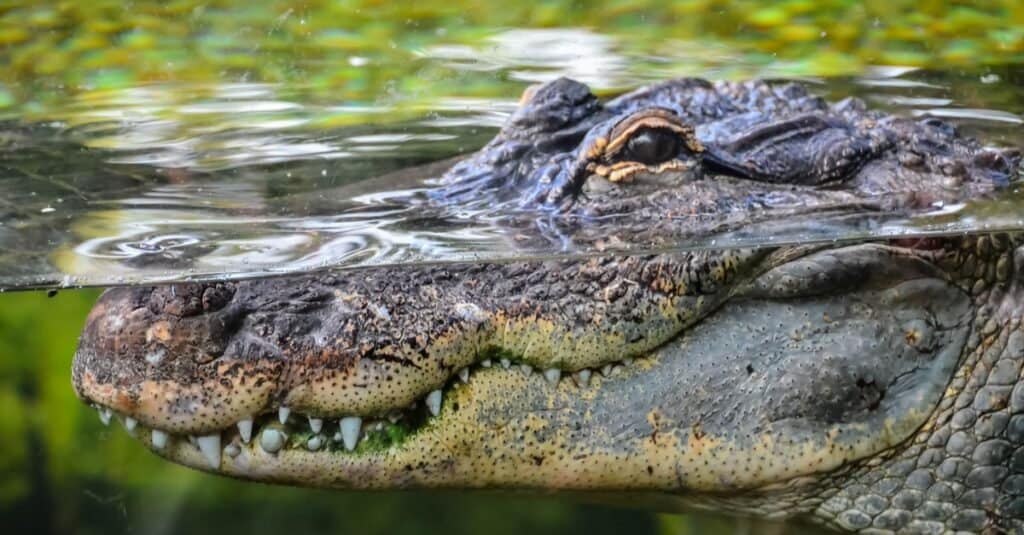
A big crocodile waiting for its prey just below the surface. Crocodiles have the strongest bite of any animal in the world.
©underworld/Shutterstock.com
The American crocodile is also amongst the most interesting reptiles in North America! The American crocodile is one of the largest reptiles in North America with a weight between 880 and 2,000 pounds! This crocodile inhabits southern Florida and Cuba. Populations also exist in parts of central and south America.
Interestingly, American crocodiles are capable of producing many offspring. A female is fertile for 20 years after reaching sexual maturity and lays between 10 and 80 eggs at a time! Sex determination of the offspring is then dependent on the temperature of the nest the eggs are kept in. The American crocodile will often live up to 70 years old.
In general, crocodiles are considered more dangerous to humans than alligators. Amongst crocodiles, however, the American crocodile is not incredibly aggressive. Although, there is increased ferocity in females when they are guarding their eggs. The American crocodile is responsible for 36 human attacks between 1995 to 2017. The saltwater crocodile and Nile crocodile are considered the most aggressive species but do no exist in the North American wild.
The IUCN conservation status of the American crocodile was vulnerable when last assessed in 1996. The United States Fish and Wildlife Service currently classifies the American Crocodile as a threatened species, but it remains protected from poaching and killing by the Endangered Species Act.
#2: Yellow-Bellied Sea Snake
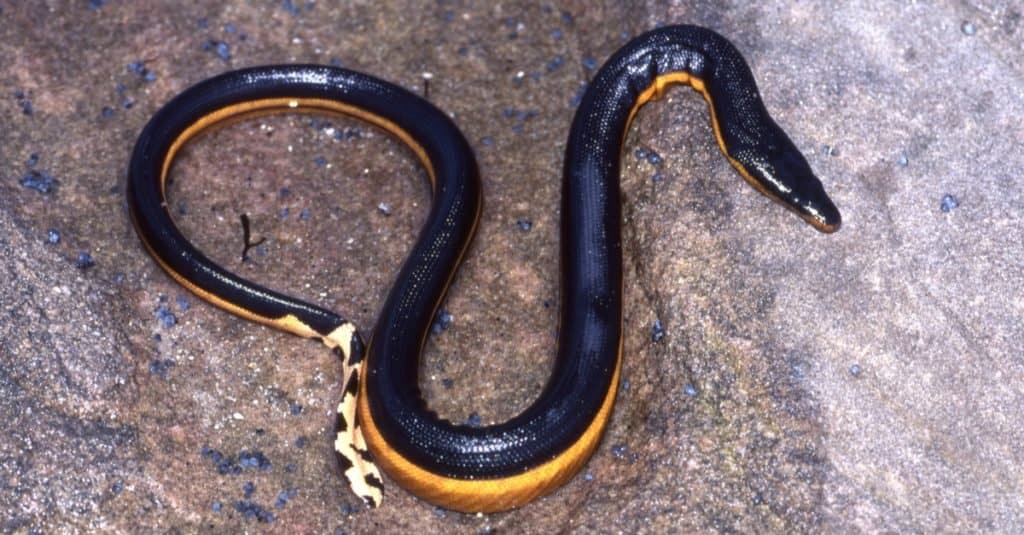
The yellow-bellied sea snake is extremely venomous.
©Ken Griffiths/Shutterstock.com
The second most interesting reptile in North America is the yellow-bellied sea snake! As its name suggests, the yellow-bellied sea snake has a distinctive yellow underbelly that is especially vibrant in contrast to its brownish-black back. Males are typically 28 inches long whereas females can grow up to 35 inches. Yellow-bellied sea snakes are the most widely distributed snake in the world and can be found in all open oceans. The Atlantic Ocean, however, is not part of its native range.
The yellow-bellied sea snake has may interesting behaviors. Despite living in saltwater, these snakes require fresh water to stay hydrated. They obtain it by drinking precipitation that forms in a layer on the ocean surface. When they hunt, yellow-bellied sea snakes wait near the surface and attack their prey by swimming backwards and lunging. Swimming backwards is a unique behavior that distinguishes the yellow-bellied sea snake from other sea snakes.
The yellow-bellied sea snake has highly potent venom. Their venom contains several neurotoxins and two additional isotoxins. Envenomation results in damage to skeletal muscle, renal damage, and neuromuscular paralysis. Antivenins exist to treat bites and as a result, bites cause very few deaths. The conservation status of the yellow-bellied sea snake is least concern.
#1: Mojave Rattlesnake
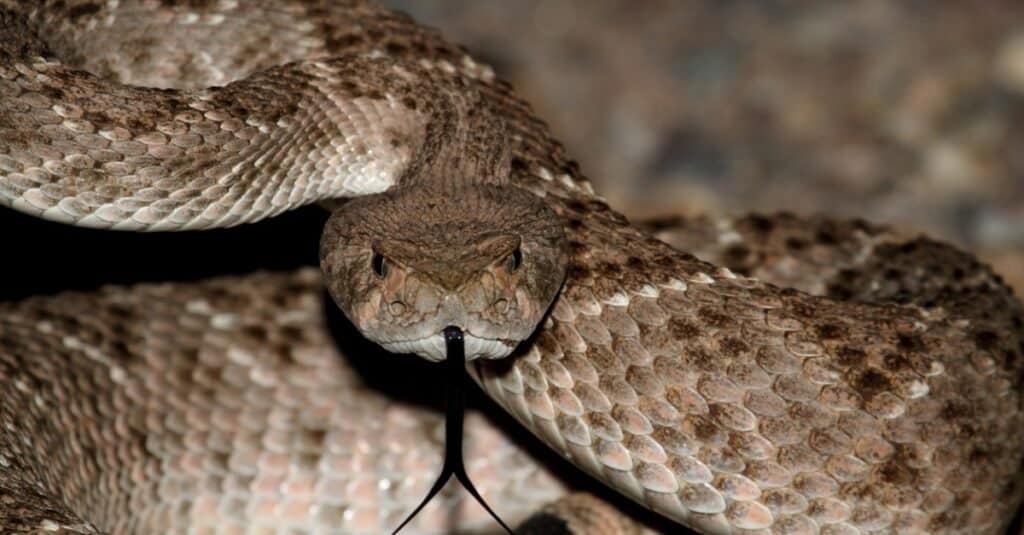
Mojave rattlesnakes have the most potent venom in the world
©iStock.com/SteveByland
The Mojave rattlesnake is the most interesting reptile in North America! This serpent is a species of pit viper that primarily inhabits southwestern United States and central Mexico. Their range includes southern California, southern Nevada, most of Arizona, southern New Mexico, and eastern Texas. Mojave rattlesnakes are a brown to pale green color and are 3 feet 4 inches long on average. Their conservation status is least concern.
The Mojave rattlesnake is amongst the deadliest animals in North America. Of all species of snakes, it has one of the most potent, toxic, venoms based on median lethal dose. Mojave rattlesnake venom is both neurotoxic and hemotoxic, meaning it attacks the nervous system and red blood cells. This venom is particularly harmful because it contains Mojave toxin. Mojave toxin is a neurotoxin consisting of two peptide subunits. One subunit is mildly toxic and is present in many other rattlesnake venoms. The second subunit of the Mojave toxin is incredibly lethal when in combination with the first subunit and is unique to the Mojave rattlesnake.
After an envenomation, it is critical to seek medical attention immediately. There may be a delayed response to the venom that could cause one to underestimate the severity of the bite. Symptoms of severe envenomations include changes in vision, difficulty speaking, difficulty swallowing, muscle weakness, respiratory distress, and respiratory failure. Despite the lethal potential of the Mojave rattlesnake and its potent venom, they are responsible for few deaths because of widely available antivenin.
List of the Most Interesting Reptiles in North America
- Legless Lizard
- Nile Monitor
- Alligator Snapping Turtle
- Burmese Python
- American Crocodile
- Yellow-Bellied Sea Snake
- Mojave Rattlesnake
The photo featured at the top of this post is © iStock.com/SteveByland
Thank you for reading! Have some feedback for us? Contact the AZ Animals editorial team.






